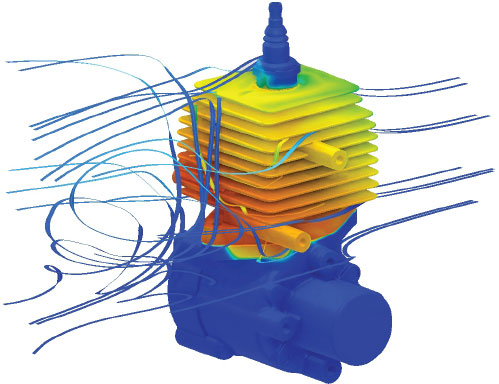Thermal Optimization for Energy Efficiency
Design Exploration and Optimization News
Design Exploration and Optimization Resources


Latest News
December 6, 2016
Gina, the cat who suffers me, is proof that most everything has an optimal operating temperature and thermal condition. On sunny days, she roams the house sleeping in shafts of sunlight. On dank days, she usurps my lap. If only it were that simple to engineer one’s thermal goals. Today’s Check it Out link goes to an on-demand webinar that shows how multiphysics simulation can help achieve thermal goals, often faster than a cat’s leap.
The summary of “Thermal Optimization for Energy Efficiency” from ANSYS is that multiphysics simulations enable you to tune analyses to the fidelity you need. It shows how you can capture thermal processes in simulations, identify multiphysics interactions impacting performance and achieve thermal optimization using integrated design optimization tools.This webinar has two parts and a Q and A. It opens outlining the thermal issues that designers, engineers and researchers in such industries as aerospace, automotive, consumer products, electronics, process equipment and semiconductors work with. The jobs could be improving energy transports, developing batteries and so on, but the common thread is that coupled-physics simulations help you discover what’s happening in thermal processes and gain an understanding of how to manage phenomena.
The second part, beginning at the 10:10 mark, moves on to real-world examples. Among these are thermal optimization of a shower head design, heat removal from LEDs, gas turbine blade optimization, induction machine cooling and heat exchanger efficiency.
 Multiphysics simulation-based design analyses can help engineers, designers and researchers understand and manage thermal conditions to achieve optimal and reliable performance. Image courtesy of ANSYS Inc.
Multiphysics simulation-based design analyses can help engineers, designers and researchers understand and manage thermal conditions to achieve optimal and reliable performance. Image courtesy of ANSYS Inc.Technically, these are case studies, so they cite companies and toolsets like ANSYS CFD, ANSYS Fluent and ANSYS Mechanical. However, these segments are more technically in-depth and illustrated than the norm. Think breakout sessions at a technical conference.
The shower head design and heat exchanger segments are particularly interesting. The former covers evaluating droplet streams and thermal losses for water and energy efficiency. Previously, the company produced one prototype a week. Now they do 12 simulations a day.
The heat exchanger analysis uses the ANSYS Fluent Adjoint solver to find the optimal fin shape to maximize thermal efficiency. Explaining the job and the methodology takes a few minutes, the calculation took just one second. Quick as a cat.
“Thermal Optimization for Energy Efficiency” is part of the ANSYS “Breakthrough Energy Innovation” multimedia web series, which is where you’ll land after registering for this on-demand webinar (ANSYS e-mails you the webinar link). Pounce on today’s Check it Out link to get started. Well worth it.
Thanks, Pal. – Lockwood
Anthony J. Lockwood
Editor at Large, DE
Subscribe to our FREE magazine, FREE email newsletters or both!
Latest News
About the Author
Anthony J. Lockwood is Digital Engineering’s founding editor. He is now retired. Contact him via [email protected].
Follow DE




